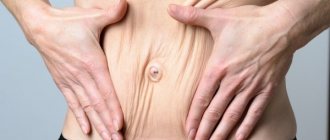If you liked the article, share it on social networks! Thank you!
The best way to quickly lose weight without exhausting diets and harm to your health is to fight excess weight with natural methods. Strict diets may work for the time being, but they will never be a long-term solution to this problem. In fact, they can even slow down your metabolism and prevent cells from functioning properly. Thus, you must rearrange your lifestyle so that you can lose excess weight effortlessly at home. In this article, we have listed 30 ways to lose weight without dieting and get rid of belly fat, which will help you get rid of fat in a truly healthy way and stay in great shape all year round.
Tested by many people and by me personally, the main way to achieve a slim figure is proper nutrition. And here we are not talking about a miracle product that burns belly fat or a secret supplement. It is necessary to adhere to a balanced diet, consume proteins, carbohydrates and even fats, include fiber in the diet, eat a lot of vegetables and will give a much greater effect than any mono diet such as buckwheat, kefir or water. Follow the recommendations below to get the body of your dreams without exhausting loads with benefit and pleasure.
What is obesity
Obesity is defined as excess body weight by 20 percent. Deposits are concentrated in the cells around the organs and in the tissue under the skin. Obesity can appear at any age, the most dangerous period is 20-60 years. Women are more susceptible to the disease. Obesity is divided into two types:
- female (gynoid), when deposits are localized in the thighs;
- male (android), if fat accumulates in the abdominal area and above it.
Obesity is primary when weight increases not due to other diseases. This happens in most cases and is dangerous due to complications that gradually worsen health. Secondary obesity is less common. The cause is diseases of the nervous and endocrine systems.
The exact cause can only be determined by a doctor when visiting a clinic, for example, the Naro-Fominsk medical center - https://glavclinics-narofominsk.ru/
The accumulation of excess fat visually changes a person's appearance. The disease is divided into 4 degrees of severity. To create the right treatment regimen, it is important to determine the type of obesity. It could be:
- Nutritional. It appears more often in women with a predisposition to obesity. Weight is gained gradually, and the endocrine system is almost not affected. In this case, it is enough to follow a diet and exercise.
- Hypothalamic. Weight gains quickly and fat accumulates on the thighs and abdomen. The skin stretches greatly and becomes dry. Such obesity often occurs against the background of injuries or diseases, which need to be treated first.
- Endocrine. Caused by hormonal imbalances in the functioning of the thyroid gland and gonads. This is taken into account first when treating.
- Painful lipomatosis. Otherwise it is Dercum's pathology. Areas with fat accumulation are very sensitive to pressure. Therefore, treatment of the cause is required first.
With obesity of 2-4 degrees, disruptions appear in the digestive, respiratory and cardiovascular systems.
How to prevent obesity
Obesity is a chronic disease affecting an increasing number of children, adolescents and adults.
Experts are seeing the onset of type 2 diabetes earlier in life (usually a disease seen in adults), as well as obesity-related cardiovascular disease and depressive disorders in children and adolescents. The longer a person suffers from obesity, the more significant the risk factors associated with it become. Given the chronic diseases and conditions associated with excess body weight, and the fact that obesity is difficult to treat, prevention is extremely important.
The main reason why obesity prevention is especially important for children is that the likelihood of obesity after reaching a certain age in children with a problem of excess weight, according to experts, will increase from 20% at the age of four to 80% during adolescence.
Preventing obesity in infants
The longer babies are breastfed, the less likely they are to develop weight problems later in life. Breastfed children are 15-25% less likely to become obese. For those who are breastfed until six months of age or longer, the chance is 20-40% lower.
How to treat obesity
Before treating obesity, the reasons for weight gain are determined. First, a diagnosis is carried out (the ratio of body weight to height of a person). It is necessary to determine the degree of obesity:
- 25-29.9 – slight excess weight (not critical, just adjust your diet);
- 30-34.9 – 1st degree;
- 35-39.9 – 2nd degree;
- more than 40 – 3rd degree.
Treatment of obesity is combined, several areas are involved at once. Then the effectiveness of therapy will be significantly higher. Hospitalization is extremely rarely required; treatment is carried out at home. The main thing is that the person himself is determined to achieve results. But you can’t suddenly lose weight; you need the process to go smoothly. This will help avoid health problems.
Diet for obesity
First of all, pay attention to nutrition. There are many different diets now, but some of them are even dangerous to health. After strict restrictions, weight is gained very quickly. You should also not completely give up food. To smoothly lose weight, it is enough to follow a number of rules:
- You need to burn more calories per day than you consume. If physical activity is average - no more than 2000 kcal. With sedentary work and lack of love for sports, 800 kcal daily is enough. However, it is difficult to maintain such a regime; it is better to stick to 1200 kcal.
- The diet must include proteins, at least 80 g per day. They are necessary for the construction of new cells and give a feeling of satiety. Protein deficiency is compensated for by eggs, dairy products, lean fish and seafood.
- You can’t completely give up fats, but you need to keep your intake to a minimum. You should eat no more than 50 g per day. It is better to replace animals with vegetable ones, season vinaigrettes and salads with them.
- Eliminate pork, duck, and lamb from your diet. They are replaced by veal, chicken and turkey. All sausages and spicy foods are prohibited. Semi-finished products and smoked meats.
- From dairy products, choose only those with a small percentage of fat content (no more than 10 percent).
- How to treat obesity - the basis of the diet should be vegetables, fruits and berries. Legumes, grapes, melons, bananas, and potatoes are prohibited.
- The amount of carbohydrates consumed is reduced, no more than 250 g per day. Sweets, sugar, confectionery and bakery products, pasta, and ice cream are excluded from the diet.
- Alcoholic and carbonated drinks are prohibited. They only increase appetite, and many also contain sugar.
- Minimize salt consumption; no more than 8 g per day is allowed. But this amount should be even less if there are cardiovascular diseases.
Fried foods are excluded from the diet. It is allowed to eat steamed, stewed, boiled, baked. If meat is being cooked, then all the fat is first cut off from it. Bread, pastries, cocoa, and canned food are excluded from the diet. If you don’t have the strength to give up sweets altogether, you can replace them with natural honey.
You need to eat 5-6 times a day, but in small portions. Mono-diets are also harmful, when people eat only one type of product (apples, kefir, etc.). This will also provoke problems with the gastrointestinal tract.
Possible causes of obesity
At first glance, the reason for obesity seems obvious: if you consume more calories than you burn in the process of life, you gain weight. But, as is often the case, the most obvious explanation is not always the most comprehensive.
Risk factors in the case of obesity can be: unfavorable genetic predisposition, socio-economic conditions, features (or disorders) of metabolic processes, and lifestyle can also play an important role. Some endocrine disorders, certain diseases and medications can also lead to severe weight gain and the beginning of the fight against obesity.
The most common causes of obesity
Genetics. Studies have shown that the predisposition to obesity is inherited. Your chances of being overweight increase by 25 percent if one or both of your parents are obese. Heredity also affects where fat accumulates most - on the thighs or in the abdomen.
Metabolic disorders. We all spend energy differently. The course of metabolic processes and the functioning of hormonal secretions are individual for everyone, but these are one of the determining factors in the issue of gaining excess weight. Recent research demonstrates how levels of ghrelin, a peptide hormone known to regulate appetite, and other peptides, both create feelings of hunger in us and signal satiety.
Lifestyle – The habit of overeating combined with a sedentary lifestyle contributes to obesity. Everything can be changed by choosing one way of life or another. If you go on a diet where a higher percentage of your calories come from sugary, high-fat, refined foods, you are likely to gain weight. As modern families are less and less able to find time to quietly gather around the dining table for a meal, people are looking for inexpensive ways to relieve hunger during the day, and most find a solution to the problem in such high-calorie and unnatural foods and drinks as fast food. Add to this the lack of regular physical activity, and now an adult has a problem - it is difficult for him to start fighting obesity, maintain an optimal weight or lose extra pounds. For children, risk factors will be ways of spending time that do not consume energy, for example, sitting in front of the TV or at the computer.
Goal setting in the fight against obesity
The most important part of any program to combat obesity is proper goal setting. Yes, you can lose weight for the sake of public opinion or to keep up with fashion, but it may be more important to consider that losing just 5-10 percent of excess weight will have a significant positive impact on your overall health.
Fight obesity
It's hard to find two people who are exactly alike, so it's important to come up with a weight loss plan that works for you. The question is whether it would be right for you to lose 0.5-1 kg per week or is it better to take your time and strive for 0.3 kg in the same period. At the same time, even a more gentle option for combating obesity means that in a year you lose about 11 kg, and if you stick to this course for more than three years, you will reach about 35-36 kg. No matter what anti-obesity program or obesity treatment plan you choose, not rushing will be more effective and healthier in the long run because rapid weight loss often results in rapid return of the lost pounds.
There are five main methods for treating obesity and weight problems: diet, exercise, lifestyle changes, non-surgical treatment and finally surgery.
Diet for obesity - effective programs to combat excess weight
Fad diets appear and disappear from the pages of fashion magazines. Some of them, such as low-calorie, high-protein or low-fat diets, may have the desired effect here and now, but they can also threaten your health in the long term. In fact, the most effective long-term weight loss programs rely heavily on the principle of limiting the number of calories consumed while increasing daily physical activity so that the body spends more than it receives and the fight against obesity is effective.
Fasting can lead to rapid weight loss, but both muscle mass and fat are lost. It makes sense to resort to so-called “liquid” diets, which can be followed only under the supervision of a doctor, for a short period of time, as a cleansing of toxins, for example. But you shouldn’t expect long-term results from them.
Fad diets that have not been labeled by doctors as posing an immediate threat to the body's health are still not a healthy solution to the problem of obesity. However, if you follow certain dietary recommendations, they can lead to weight loss and weight loss.
But in order to lose weight and, most importantly, maintain this result, instead of looking for another miracle “diet,” try to create an individual nutrition plan. An anti-obesity plan tailored to your personal eating habits will have a greater chance of not only being successful, but also providing lasting results. A balanced diet that limits calorie intake to 1,200 to 1,400 for women and 1,500 to 1,800 for men should do the trick. A professional nutritionist can help you create a personalized diet plan based on your specific situation.
Eat a varied diet!
Not all fats are bad. We know that polyunsaturated and monosaturated fats provide health benefits, such as helping to maintain a healthy cardiovascular system. That is, nuts, seeds and certain types of oils, such as olive, safflower and canola, deserve a place of honor in your healthy eating plan.
Opt for unrefined foods like brown rice and whole grain bread, and leave white rice and muffins on the counter. Whole grain foods will give you more nutrients and gut-healthy fiber. The body digests rougher, unprocessed, overly processed foods more slowly, which means they will not contribute to sudden spikes in insulin in the blood. This means that attacks of hunger and the ineradicable desire to “chew something again” will remain a thing of the past.
Make it a habit to include at least five servings of a variety of fruits and vegetables in your daily diet. This variety will provide your body with the full range of types of nutrients it needs.
When dining out, don't try to eat everything on your plate; ask the waiter to take away what you haven't eaten, and avoid ordering large portions. Often, portions in cafes or restaurants are too large for one person, so invite a friend to share a portion for two or order an appetizer instead of a main course.
Read labels when buying prepared foods at the supermarket. Pay close attention to the number of servings contained in one container and the serving size. If the label says a serving is 150 calories and the package contains three servings, keep in mind that if you eat the entire contents of the container, you will be consuming as much as 450 calories.
Exercises to combat obesity
If you are obese, physical activity is vital because it will help you maintain and increase muscle mass while losing fat stores. And because muscle tissue requires a higher metabolic rate and burns calories faster, as long as you eat healthy foods according to a smart nutrition plan, exercise speeds up your weight loss process.
Exercise lowers blood pressure and can help prevent type 2 diabetes. An active lifestyle can also improve your emotional well-being, reduce your appetite, solve sleep problems, increase flexibility, and lower your blood cholesterol.
Walking is a great option for obese people. Walking should start off as a light activity, say 30 minutes a day a few times a week, and gradually increase to longer daily hikes.
Consult your physician before following any exercise program.
Lifestyle changes for obesity
Most of us are accustomed to a sedentary lifestyle, and the transition to physical activity is associated with certain problems. To the office - by car, at work - sitting motionless at a desk. The habit of spending all your free time in front of the TV screen or at the computer can also contribute to the development of a sedentary lifestyle.
There are simple steps you can take to increase your daily activity levels. Remember, even the little things matter!
- Take the stairs instead of the elevator or escalator.
- Park your car at the far end of the parking lot and walk to the store or office.
- Get off the bus one stop early on the way home if possible.
- Turn off the TV or video games and go into the garden, grab a rake and tidy up leafy walkways or wash your car. Just take a walk and get some fresh air!
- Find active ways to spend time that you and your whole family enjoy, such as tennis, roller skating, or camping.
- Simply by taking a critical look at your daily routine, you can find ways to carve out more time for physical activity each day beyond your mandatory fitness routine.
- Perhaps your place of work is not conducive to maintaining excellent physical shape. However, there are some positive changes that can easily be made part of your daily routine in any setting: Bring healthy snack options, such as sliced fruits and vegetables, to always have on hand when hunger strikes.
- Avoid going to office parties and get-togethers on an empty stomach—plan ahead to avoid the temptation to binge on high-calorie treats like birthday cake and sweets.
Treatment of obesity without surgery
If your own efforts to lose weight have been unsuccessful and/or if there are underlying health problems that are preventing you from losing weight, it is worth contacting your doctor. Possible treatment may include:
- Drug treatment of obesity-related health problems.
- Implementing certain changes to improve eating habits and increase activity levels.
- Therapy to address any eating disorders (medication may also be required).
Surgical treatment of obesity
Surgery to treat obesity (bariatric surgery) is the only option available today that is effective in combating morbid obesity in people for whom more traditional measures such as diet, exercise and medications have not been effective. Potential candidates for surgery include:
- People with a BMI over 40
- Men who are 100 pounds (45 kg) over the recommended body weight, or women who are 80 pounds (36.2 kg) over the recommended body weight.
- Individuals with a BMI of 35-40 who have underlying medical conditions such as obesity-related type 2 diabetes, sleep apnea, or cardiovascular disease.
Obesity due to compulsive overeating
All of the above methods of combating excess weight may not give good results if the root of the problem is eating disorders. In such cases, a slightly different technique is needed, which includes, first of all, psychotherapy under the guidance of a competent specialist.
Compulsive overeating has the same nature as bulimia - it is an eating disorder. However, if with bulimia a person artificially induces vomiting after eating or abuses laxatives to get rid of what he has eaten, this does not happen in this case. A person simply consumes an excessively large amount of food in a short period of time, “eating” negative emotions, stress and depression. Binge eating disorder (BED) is treated in the same way as bulimia and other eating disorders, with an emphasis on psychotherapy as the main component of successful treatment. Although there are many different techniques, it is always recommended to start by seeing an experienced therapist who specializes in treating eating disorders. Evaluation and supervised drug treatment are also part of the standard approach to managing BED. A medical examination is carried out to identify possible health problems associated with the underlying disease and to select the optimal treatment program.
Psychotherapy for compulsive overeating disorder
Psychotherapy is the most common treatment for eating disorders and, according to research, the most effective. Psychotherapy may take some time and require certain financial costs, but it will help not only solve the problem of painful overeating and, as a result, excess weight, but also improve emotional health and help improve the quality of life in general. The focus of psychotherapeutic treatment is to identify, address, and prevent relapse of the underlying emotional and cognitive disturbances that led to the onset of the compulsive disorder.
Cognitive behavioral psychotherapy for obesity
This approach helps identify and correct dysfunctional thought patterns that trigger and perpetuate unhealthy food abuse. In other words, a person is helped to understand, identify and change his irrational thoughts (the “cognitive” part of consciousness), which, in turn, directly affect behavior (for example, encouraging healthy eating through proper goal setting, a reward system, etc.).
If you have an eating disorder, treatment will be given over a period of time with specific goals in mind. As with any other psychotherapy, sessions can be conducted either on an outpatient basis (once a week) or in a hospital setting.
CPT will help a person with compulsive overeating disorder break their unhealthy eating patterns, adjust their habits, and learn to avoid situations that may trigger the craving for overeating. In parallel, therapy helps the patient find healthier ways to cope with stress.
Exercises, sports
To lose weight you need to exercise or exercise. You need to move more - you can just walk down the street at a brisk pace for 40 minutes every day. There is also a special complex of physical therapy to treat obesity:
- Stand up, hands on your belt. Turn the body in different directions, 10 times in each direction.
- Standing, place your hands behind your head. Turn the body left and right – 10 times.
- Lie on your back, arms extended along your body. Raise your bent left leg and pull it towards your chest. Then the actions are repeated with the right one. Repeat the exercise 7 times for each leg.
- Lie on your back and imitate the movements of your legs, as when riding a bicycle. Repeat the exercise after 30 seconds.
- Sit on the floor with your legs extended. Bend over, trying to touch your toes. Keep your knees straight. The exercise is repeated 6 times.
- Stand up and slowly rise on your toes. Lower yourself back down onto your full foot and squat down. The heels should be pressed firmly to the floor. The exercise is performed 7-8 times.
- Walk in place for several minutes, raising your knees as high as possible.
But we must remember that any physical activity should not be exhausting, but moderate.
Dominant in the fight against excess weight
That is why, in order for the brain to allocate its resources to solving the problem of losing weight, our FIRST and MAIN task is to excite the dominant in the fight against excess weight.
With this action we will bring all the capabilities of the brain to our side! We will force the subconscious to work on this task, and at every step it will look for and find solutions.
How we configure our subconscious (with the help of emotional images), that’s how it will work, that’s what it will achieve.
But look at how we act now. Suppose that you want to be slim and beautiful, but if an emotionally charged image of yourself as fat has taken root in your subconscious, or if you do not believe that losing weight is even possible, then there is no doubt that in this case nothing will come of losing weight.
The desires of consciousness (mind) are nothing compared to the ancient power of the subconscious, and in this case you did not want to win this power over to your side.
To avoid this, you need to create a bright, emotionally charged image for yourself. In our case, the main goal of creating an image is to see yourself thinner, to see how the fat has disappeared from your body.
Start with the statement: “I am losing fat every second.” Then imagine the fat draining like water from your body. How it melts like snow under the rays of the sun. It evaporates like water on glass on a hot day.
This image of fat draining from your body is very useful to keep in mind during physical training - the effectiveness of training increases by 3 times.
If your imagination is well developed, then you can go further. Imagine that fat is gradually evaporating from your body, and now your body has reached the condition you need! It's lost weight! Be sure to positively reinforce this image of yourself as slim and beautiful (you will delight yourself).
Next, imagine as vividly as possible: you are slim and beautiful, you get out of bed in the morning, stretch, do exercises, douse yourself with water. Here you are walking down the street and people look at you, see your reflection in the window and smile at it. So you come to work, the employees compliment you, congratulate you, and start asking you how you did it. You meet an acquaintance whom you have not seen for a long time, at first he does not recognize you and exclaims: “God, this cannot be! How did you lose weight!”, “It’s a miracle!” You feel proud and confident from the changes that have occurred.
It is with this state of joy and happiness that you must reinforce the image of the future.
You need to evoke the desired image for 10-30 minutes a day (you can do it 2 times for 5-15 minutes). Use the time of traveling in the subway, minibuses, taking a shower, etc. for this. There are many opportunities to allocate 10-30 minutes a day. It is highly advisable to evoke such an image early in the morning - the morning mood sets the tone for the whole day.
Drug treatment
Obesity can be treated with medications or dietary supplements. However, their consumption should be supervised by a nutritionist. There are two types of drugs. Some reduce appetite, others impair the absorption of nutrients. The most popular drugs include:
- Orlistat. It prevents fat from being absorbed into the intestines and suppresses pancreatic activity. After using the drug, the urge to go to the toilet may become more frequent. This can be avoided by removing fatty foods from the menu.
- Lindax. It is an antidepressant that reduces appetite. An overdose of the drug can cause the development of anorexia. Side effects - a sharp increase in blood pressure, dyspeptic disorders, insomnia, headaches.
- "Rimonabant." This is a new drug that acts on the brain and reduces appetite. However, it can provoke mental disorders.
- "Metformin." It was first prescribed for type 2 diabetes. Then its effectiveness for the treatment of obesity was discovered. Does not cause side effects.
However, drugs are selected individually, and if there is no desired effect, you need to stop using them. Doctors recommend using Sibutramine for treatment. With its help, weight is reduced by 10 percent.
You need to take it before breakfast, 10-15 mg. The advantages include the possibility of taking it for a long time and safety. Side effects that may occur are insomnia, gastrointestinal disturbances, increased blood pressure.
This is a description of only one drug. They all have their own dosages, contraindications, and side effects. Other drugs used to treat obesity include Fluoxetine, Mazindol, Bupropion, and Phendimetrazine.
How to get rid of obesity at home
Treatment takes place at home. Hospitalization is possible only in extremely advanced conditions, a large number of deviations from the norm in the functioning of the body. The support of family members and the desire of the patient himself to lose weight are important. By contacting specialists, the patient receives recommendations that need to be followed. The dynamics of changes are noted by the patient himself or during periodic visits to doctors.
Comprehensive treatment of obesity necessarily includes increasing activity, changing diet - selecting the right foods, avoiding overeating. The correct diet is not to eat at night, not to eat until you are completely full, but until you feel slightly hungry. Balanced foods low in fat and carbohydrates are what will help you regain your waistline and lose weight.
Diet
One of the important things in treating obesity is proper nutrition. The composition of products, meal times, and cooking technology are taken into account. Total calorie consumption is reduced to 1000-1400 kcal/day. It is advisable that the chosen diet is not completely opposite to usual culinary preferences. Then it will be easier to stick to it for some time needed to lose weight.
The benefits will be:
- fresh vegetables, fruits high in fiber;
- vegetable oils with monounsaturated fatty acids (for example, olive);
- lean types of meat, fish;
- dairy products.
Acceptable salt intake is up to 3 grams per day. It is advisable to divide the daily diet into 5-6 meals, this will help reduce the feeling of hunger and make the diet easier to tolerate. You should not choose a diet with a calorie content below 800 kcal/day - it is difficult to sustain, and the result will not be greater than with a calorie content of 1200 kcal/day. In addition, weight is gained faster after strict restrictions. It is necessary to exclude from the diet:
- sweet juices, sodas;
- white bread, pastries;
- smoked meats, sausages, canned food;
- fatty meats and fish;
- Replace cocoa, chocolate, confectionery, sugar with honey;
- pasta, potatoes.
Physical activity
The best friend of those losing weight is sports. And although it is more difficult for obese people to perform physical exercises, it is necessary to choose a suitable complex and gradually increase the load. The purpose of physical education is to increase energy consumption in the body, normalize metabolism, and regulate appetite. Strength exercises that increase muscle mass are good. You should start with walking, gradually adding load. Swimming is a good choice - a gentle sport that provides an optimal load on the muscles, but does not overload the joints.
Drug therapy
In modern medicine there are a number of drugs with proven effectiveness. Medicines for obesity are prescribed by a doctor as part of a complex treatment starting from a BMI of 27 kg/m2. Contraindications for most drugs include pregnancy, lactation and mental disorders. Medicines are divided into two main groups - those that reduce appetite and those that impair the absorption of nutrients in the gastrointestinal tract. Official medicine recommends the following drugs: Sibutramine, Orlistat.
Sibutramine (Meridia) enhances the effect of neurotransmitters on satiety centers to reduce appetite. Weight is reduced by 10%, the amount of fat is over 22% - these are the results of the studies. Take 10-15 mg per day before breakfast. Advantages of Sibutramine: safety and possibility of long-term use. Among the disadvantages - possible side effects: insomnia, increased blood pressure, disruptions in the gastrointestinal tract. There are contraindications: arrhythmias, liver and heart dysfunction.
Orlistat (Xenical) reduces fat absorption by an average of one third. Dosage: 120 mg 3 times a day with meals or within 1 hour after meals. Pros: high efficiency, possibility of long-term use, lowering cholesterol and blood pressure. Cons: side effects - abdominal pain, defecation problems. Do not use if you have urolithiasis.
There are groups of other drugs whose use is justified for obesity:
- amphetamine group, which increases energy expenditure;
- centrally acting drugs (Mazindol, Phendimetrazine and others);
- antidepressants (Bupropion and Fluoxetine).
However, their effectiveness has not been proven, and there are contraindications. Because of this, they are rarely recommended, or based on the patient's health condition, and are used under the supervision of a physician. In recent years, nutritional supplements have appeared that promise a quick victory over excess weight. Doctors recommend avoiding their use due to unproven effectiveness and unstudied composition.
Surgical intervention
Sometimes, if a person’s weight is 50 kg or more more than normal, it is possible to get rid of obesity only through surgery:
- Gastric bypass surgery. Its volume is reduced by inserting a tube. Through it, food quickly ends up in the stomach. This method is suitable for those whose obesity has reached degree 4 and much higher. The stomach does not suffer, and complications are prevented by medications.
- Vertical gastroplasty. The method involves stitching the stomach to reduce its volume. The operation is safe and effective.
- Gastric banding. The stomach is compressed with a special belt. This reduces the volume of the organ, then saturation occurs even with a small portion of food. The operation may cause complications in the form of the band slipping and stretching of the stomach walls.
All surgical procedures carry some risk. Sometimes this can be life-threatening. Therefore, operations are carried out only in extreme cases.
Surgical methods of treatment
In some severe cases, when excess adipose tissue threatens the patient’s life, conservative control of obesity does not provide a sustainable result of weight loss, and surgery is resorted to. There are two surgical options:
- Bypass or resection of the small intestine to reduce the absorptive surface of the intestine. Resection is rarely used due to risks and side effects. The bypass method is effective, but complicated, not performed in all clinics, and the cost of the operation is high.
- Gastrorestrictive operations – reduce the volume of the stomach. Plastic surgery is performed using a bandage or a special synthetic tape using different techniques.
Treatment of obesity with folk remedies
Obesity can be treated with folk remedies, but this is more of an auxiliary method. It will become more effective with regular use of all methods. The products are prepared according to specific recipes. If an allergic reaction occurs, such treatment should be suspended.
Decoctions and infusions
Infusions and decoctions of medicinal herbs reduce appetite, restore metabolism, and strengthen immunity. Recipes for treating obesity using traditional methods:
- Leaves of currant, rowan, lingonberry, yarrow, mint and medicinal chamomile flowers are taken in equal proportions. Pour 300 ml of boiling water over a tablespoon of the mixture. Leave in a thermos for 3 hours. Then filter and drink three times a day, half a glass.
- A mixture is made from lemon balm, birch and strawberry leaves, St. John's wort, and rose hips. Then 2 tbsp. l. crushed plants, pour 300 ml of boiling water and leave for 2 hours. The drink should be drunk three times a day, 100 ml.
- A mixture is made from licorice rhizomes, buckthorn bark, birch leaves, chicory, corn silk, mint, bud tea shoots, parsley, and dandelion roots. Then 2 tbsp. l. the composition is poured with 500 ml of boiling water. After 15 minutes, put the container on the fire and bring to a boil. Then leave for another 2 hours in a warm place. The product is drunk 100 ml 4 times a day, before meals.
All decoctions and infusions should be drunk only fresh, so they are prepared in small quantities. This way all useful qualities are preserved.
Therapeutic baths
Therapeutic baths help cleanse the skin, pores, and remove excess fluid. The procedure helps you relax and get rid of stress, which often provokes overeating. How to treat obesity with baths:
- Pour a glass of mustard powder into warm water. Soak in the bath for 20 minutes.
- Stir in 1 l. milk 150 ml liquid honey. The mixture is poured into the bath. You need to lie in it for a quarter of an hour.
- Pour 1 tbsp. l. linden blossom with a glass of boiling water. This drink is especially effective for older women. A tablespoon of linden blossom is poured into a glass of water. After half an hour, the drink is filtered and poured into the bath. You need to lie in it for 20 minutes. Then lie down for an hour under a warm blanket.
- A soda bath has a fat-burning effect, speeds up metabolism and increases blood circulation. For the procedure, you need to take warm water and dissolve 150 g of powder in it plus 2 tbsp. l. sea salt. The bath takes 20 minutes.
During the procedure, you need to distance yourself from bad thoughts and experiences and try to completely relax. This will enhance the effectiveness of the treatment. Bath water should not be too hot - this can have a bad effect on the cardiovascular system.
Juice treatment
You can get rid of excess fat with the help of freshly squeezed juices. They are made from fruits and vegetables, help restore normal metabolism, and strengthen the immune system. How to treat obesity with juices (how to take):
- carrots, cabbage (mix 100 and 200 ml, drink throughout the day);
- dill, parsley, celery (1 tsp each);
- watermelon, apples (200 ml each);
- carrots, celery, spinach in a ratio of 7:5:4 (1 tbsp each);
- pumpkin, gooseberries (half a glass each);
- carrots, beets in a ratio of 4:1 (1 tbsp each);
- cucumber, cabbage (100 ml each).
Prepared cocktails are drunk 3 times a day. Choose juice according to seasonality. Cocktails should be drunk for two weeks, then take a break and repeat. Juices alone cannot get rid of obesity, but as a supplement they enhance the effect.
Prevention of obesity in children and adolescents
Young people usually suffer from overweight or even obesity for one simple reason - because they do not get enough physical activity and have bad eating habits. Genetic predisposition and lifestyle in general also contribute to the occurrence of such problems in a child.
There are several steps you can take to prevent overweight and obesity in childhood and adolescence. (It will be useful not only for children, but also for adults!) Our recommendations include the following:
- Gradually work to change family habits, including diet and activity levels. The focus should be on this and not on the scales. Change your habits, and your body will get rid of unnecessary ballast in the form of extra pounds.
- Be a role model. Parents who eat well and lead an active lifestyle become a guide and role model for their children, which minimizes the likelihood of future weight problems.
- Encourage physical activity. Children should get at least an hour of moderate physical activity every day. More than an hour will be good for weight loss and maintaining the achieved results.
- Reduce your time sitting in front of the TV and computer to two hours a day.
- Encourage children to eat only when they are truly hungry. Teach them to chew their food slowly without being distracted by the TV screen or book.
- Avoid using favorite treats as rewards or punishments.
- Keep skim or low-fat milk and fresh fruits and vegetables in the refrigerator instead of soft drinks and snacks high in sugar and fat.
- Try to give children at least five servings of fruits and vegetables every day.
- Encourage children to drink water rather than high-sugar drinks such as soda, sports drinks, and fruit juice drinks.
Medical wraps
Wraps help to cope with obesity. A special composition is applied to the body, and these areas are wrapped in cling film. Due to it, a greenhouse effect is created, which improves the penetration of healing substances under the skin.
At the same time, excess fluid quickly disappears, blood supply and metabolism are restored. The most effective wraps:
- Dilute 2 tbsp in warm water. l. blue cosmetic clay. You need to take enough liquid to make a liquid paste.
- Take two bars of dark chocolate. It is melted and applied warm to problem areas.
- Take 10 g of ground cinnamon and mix with 1 tsp. red pepper. Add 2 tbsp to them. l. vegetable oil and a few drops of orange oil. Stir and apply to the body. However, such a wrap cannot be done for varicose veins.
- Dried seaweed (3 tablespoons) is crushed and infused in a glass of warm water. The composition is applied to the skin after half an hour.
Before the procedures, the skin must first be cleansed with a scrub. After wrapping with film, you need to lie still for 40 minutes. After the procedure, take a cool shower and apply a nourishing cream to the body.
Massage for obesity
Massage enhances the effect of treatment. It can be done at home, on your own or in salons. During the procedure, blood circulation and lymph flow increase, metabolism accelerates, which all together helps burn excess fat. Massage is done in the form of rubbing, stroking, vibration. The session lasts 15 minutes. Massage is done at least 2 times a week, preferably daily. After the procedure, you need to lie for half an hour without moving.
You can also use ready-made herbal teas. They reduce appetite and remove excess water from the body. The listed recipes based on medicinal herbs can be supplemented with many more options.











